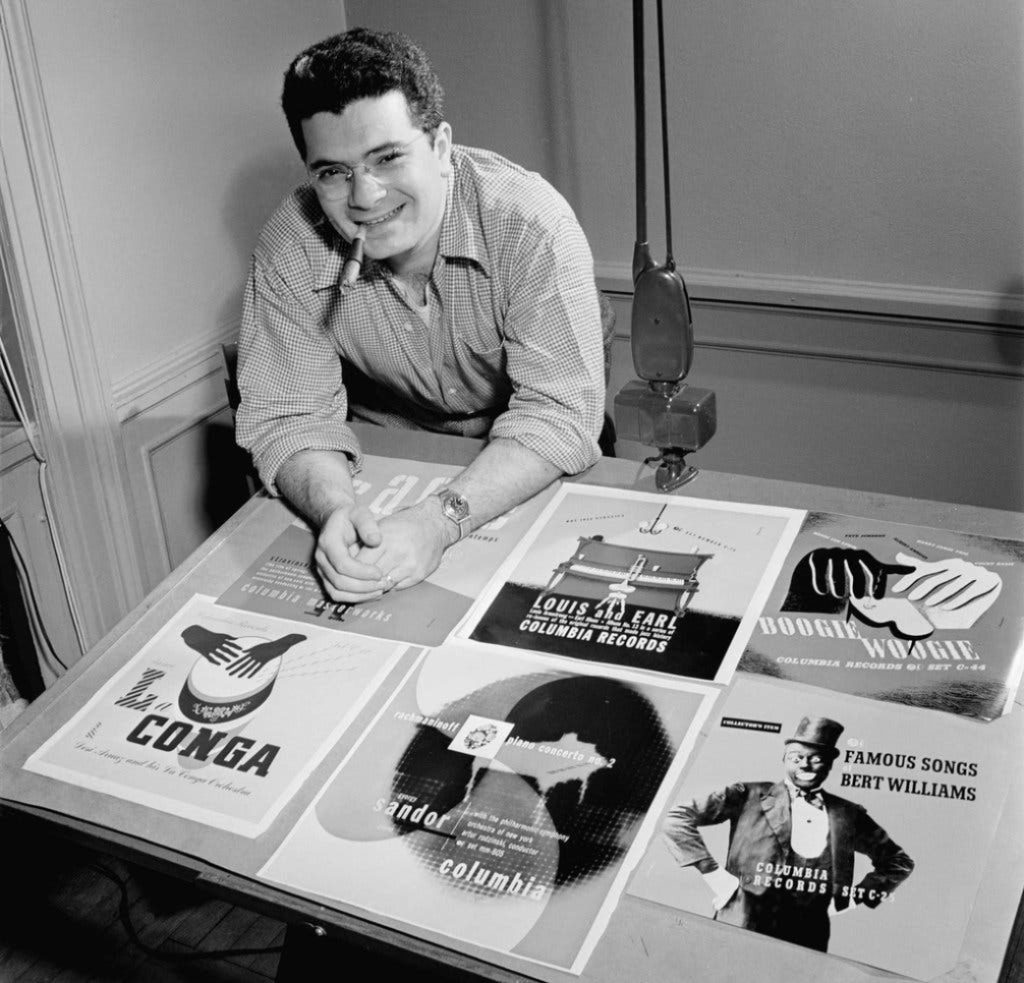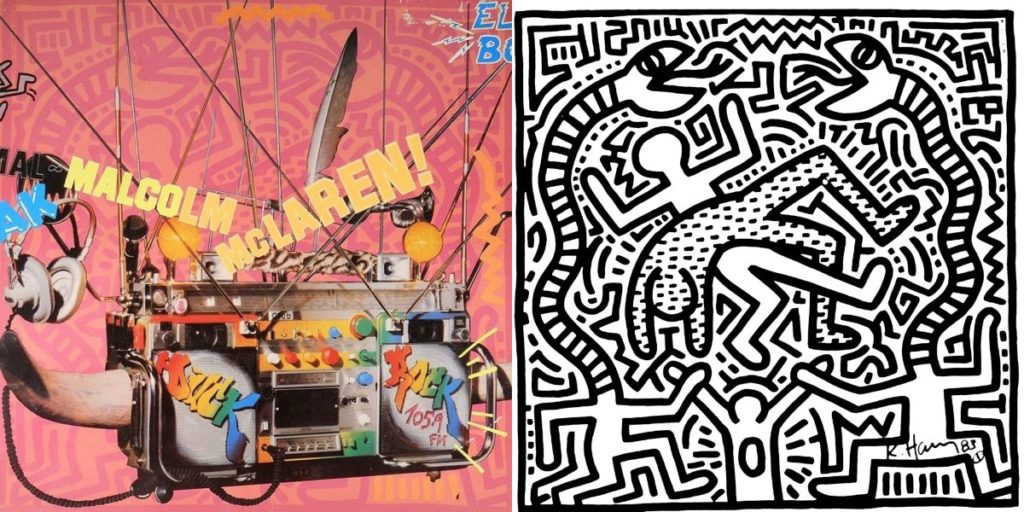Andy Warhol, Keith Haring, and Takashi Murakami are some of the superstars of The Art World who have created iconic artwork for the world’s biggest names in popular music
In his book, Art Record Covers, author Francesco Spampinato writes, “Art does not necessarily need to be experienced within the walls of museums. Anyone could build an art collection.” The art Spampinato alludes to is the oft-overlooked, but culturally significant record album cover, particularly those designed by celebrated artists. Often viewed as just a marketing tool, journalist Deep Shah says the artwork on an album serves “as a portal into what the listener can expect from (it) and even what kind of musician lies behind the creativity.”

The relationship between art and recorded popular music goes back to 1938 when Columbia Records hired its first art director, Alex Steinweiss. Credited with inventing the concept of record album covers, Steinweiss found the plain paper packaging used back then “drab and unattractive.” He utilized color, typography, illustration, and photography in all his covers and eventually developed the entire graphic language of album design. Soon, other record companies like Verve and Blue Note followed suit and released their own remarkable and iconic covers.

the concept of the record album cover. | Image by William B. Gottlieb via The Library of Congress
It wasn’t until the late 1960s that noted names from the art world started designing album covers for bands and recording artists. Andy Warhol (1928-1987), a key figure in the burgeoning Pop Art scene, created the unique artwork for the 1967 debut album of New York rock band, The Velvet Underground & Nico. The cover depicts a banana rendered in Warhol’s signature silkscreen style against a stark white background; there is no mention of the band’s name or album title, not even a band photo. Much like his unconventional paintings and avant-garde films of the time, Warhol’s artwork completely disregarded the rules of album cover design. It was irreverent, provocative, even deviant (early copies of the album featured a “peel slowly and see” sticker at the top of the fruit; peeling back the banana skin featured a flesh-colored banana underneath). It was a design that perfectly complemented the music of Lou Reed and John Cale, the band’s founding members, which had experimental sensibilities and controversial lyrics touching on drug abuse (I’m Waiting For The Man), sadomasochism (Venus In Furs), and prostitution (There She Goes Again). Although the album sold poorly upon its initial release, it has become a classic and is considered to be one of the most influential records of all time. Warhol would go on to design distinctive and collectible covers for artists like The Rolling Stones, John Lennon, Aretha Franklin, Billy Squier, even Paul Anka.

Another artist who designed striking and iconic album covers is Keith Haring (1958-1990), a former subway graffiti artist whose bold, spirited style can now be seen in major private and public collections including the Museum of Modern Art (MoMA), Los Angeles County Museum of Art (LACMA) and the Stedelijk Museum in Amsterdam, to name a few. Haring first received public attention in the early 1980s for the eye-catching illustrations he painted in New York’s subways. He soon started exhibiting in smaller clubs and galleries before exploding into the art scene in 1982 with his inclusion in two international festivals and his first major show in the Tony Shafrazi Gallery. Haring’s whimsical, cartoon-like imagery—chalk outlines of human figures, dogs, and hearts—soon began appearing in everyday items like clothing, watches, postcards, even toys. Because of Haring’s connection to New York street culture and the art world, he was commissioned to design album covers for recording artists like David Bowie, Sylvester, and several hip-hop acts. In 1983, Malcolm McLaren, the English impresario/musician/performer who gained notoriety as the man behind the Sex Pistols punk band, tapped Haring to create an illustration for his debut album Duck Rock. Originally rendered in black and white, Haring’s artwork features his signature thick outline of genderless figures and playful lines and squiggles. Like Haring’s illustration with its nod to Pop Art and street culture, Duck Rock is a collage of styles and influences. The album features hip hop, rap, sampling technology, and world music all coming together in tracks like Buffalo Gals, Double Dutch, and Soweto. Sadly, Haring passed away in 1990 due to AIDS-related complications.

Like Keith Haring before him, Banksy, the anonymous England-based street artist and political activist, has lent his distinctive graffiti imagery to around thirty commissioned album covers. One of the most famous ones he created was for Think Tank, the well-received seventh studio album from English rock band Blur which came out in 2003. The artwork features a man and woman wearing old-fashioned deep-sea diving helmets while locked in an embrace. As in Banksy’s other works, it’s satirical, subversive, and darkly humorous. Described by the band’s singer/songwriter Damon Albarn as an album about “love and politics,” Think Tank is melancholic, brooding, and strange–and Banksy’s art perfectly captures its mood and tone.

Although most musicians have little say on the concept and execution of the album artwork they commission, rapper Kanye West went one step further on his 2007 studio album Graduation, by collaborating with noted Japanese contemporary artist Takashi Murakami for its cover. The collaboration came about when West visited Murakami’s studio while on a brief trip to Asaka, Japan. Over the course of the artwork’s production, West would email ideas to Murakami, who would then develop them in his surrealistic, colorful style. Explaining the metaphor behind his artwork, Murakami says, “The cover artwork is based on Kanye’s theme of student life. School. It’s a place of dreams, of righteousness, a place to have fun. It’s also occasionally a place where you experience the rigid dogma of the human race. Kanye’s music scrapes sentimentality and aggressiveness together like sandpaper, and he uses his grooves to unleash this tornado that spins with the zeitgeist of the times.” Graduation went on to sell over 2.7 million copies while Murakami’s vibrant artwork was named one of the best album covers of 2007 by Rolling Stone magazine.

A pairing that couldn’t have been more fitting took place in 2013 with the release of Lady Gaga’s third studio album Artpop featuring cover art by Jeff Koons. Gaga and Koons seem made for each other; both are media-savvy, controversial, and polarizing. The two first met in 2010 at the Met Ball, the Metropolitan Museum of Art’s fashion event, with the chart-topping singer/songwriter confessing to the American artist how much of a fan she was. Recognized for his work dealing with popular culture, Koons came to prominence as part of a generation of artists who explored the meaning of art in a media-saturated era. Known mainly for his stainless-steel figures of rabbits and dogs that look like oversized balloons, Koons has also explored the marriage of high art and low art in his sculpture and paintings. His work for the cover of Artpop features a naked sculpture of Gaga with a blue gazing ball in front of her. The background consists of a collage of Botticelli’s’ The Birth of Venus and Bernini’s Apollo & Daphne. As in some of his previous works, Koons combines classic art with pop art to create a cover that is provocative and exuberant, much like the music in Artpop itself. Songs like Applause and Venus revolve around the themes of fame and sex, subjects Koons has dealt with in previous sculptures and paintings (he was once famously married to Italian porn star Cicciolina).

So what can we expect from album covers in the future? Even though they’ve been reduced to the size of a postage stamp on digital formats, album artwork will always be important. Not just is it the visual identifier for a particular release, but the imagery the artist creates for it is an integral part of the world the album seeks to create. When successfully brought together, art and music will always evoke moods and feelings that will stir the listener’s imagination.





